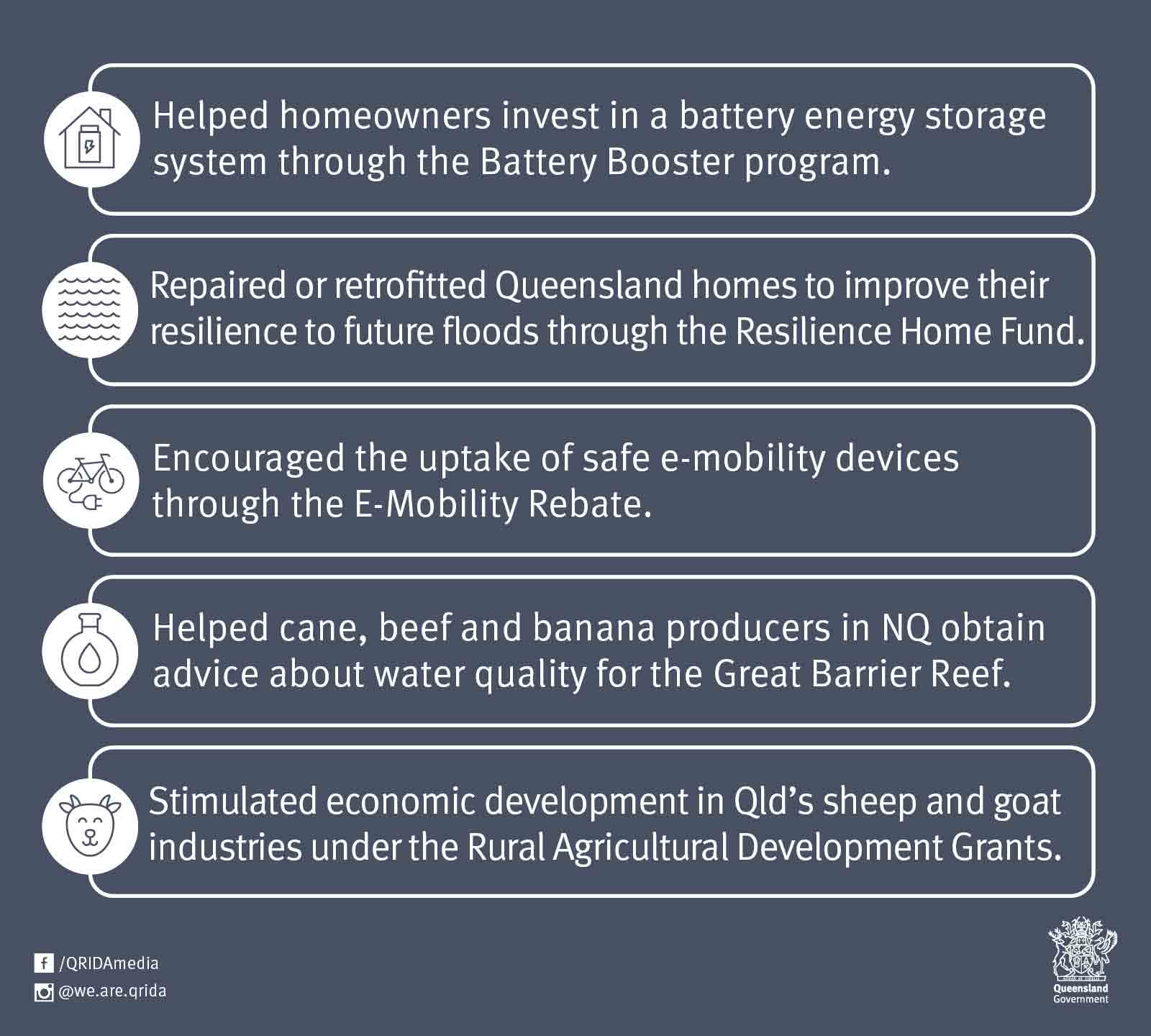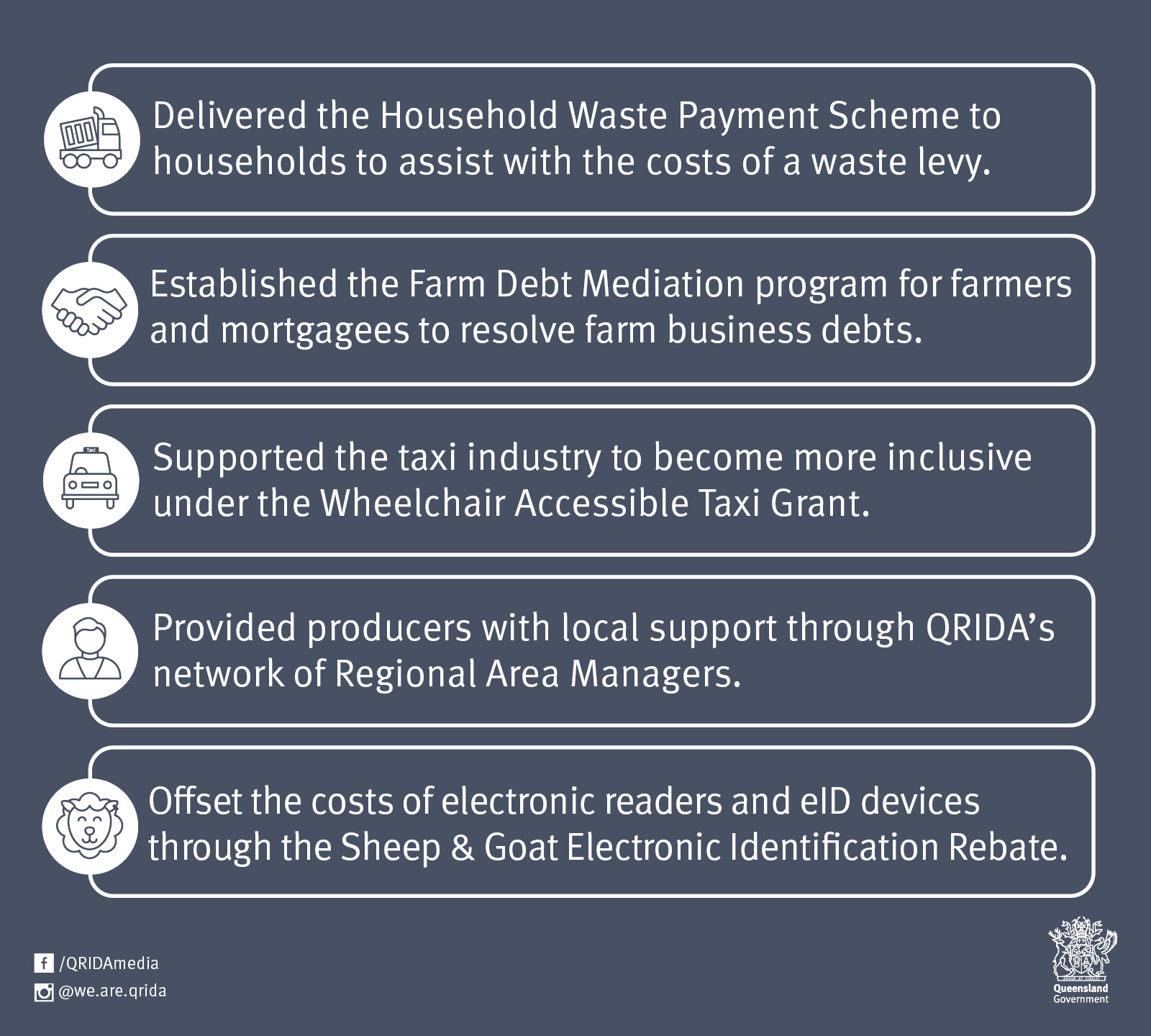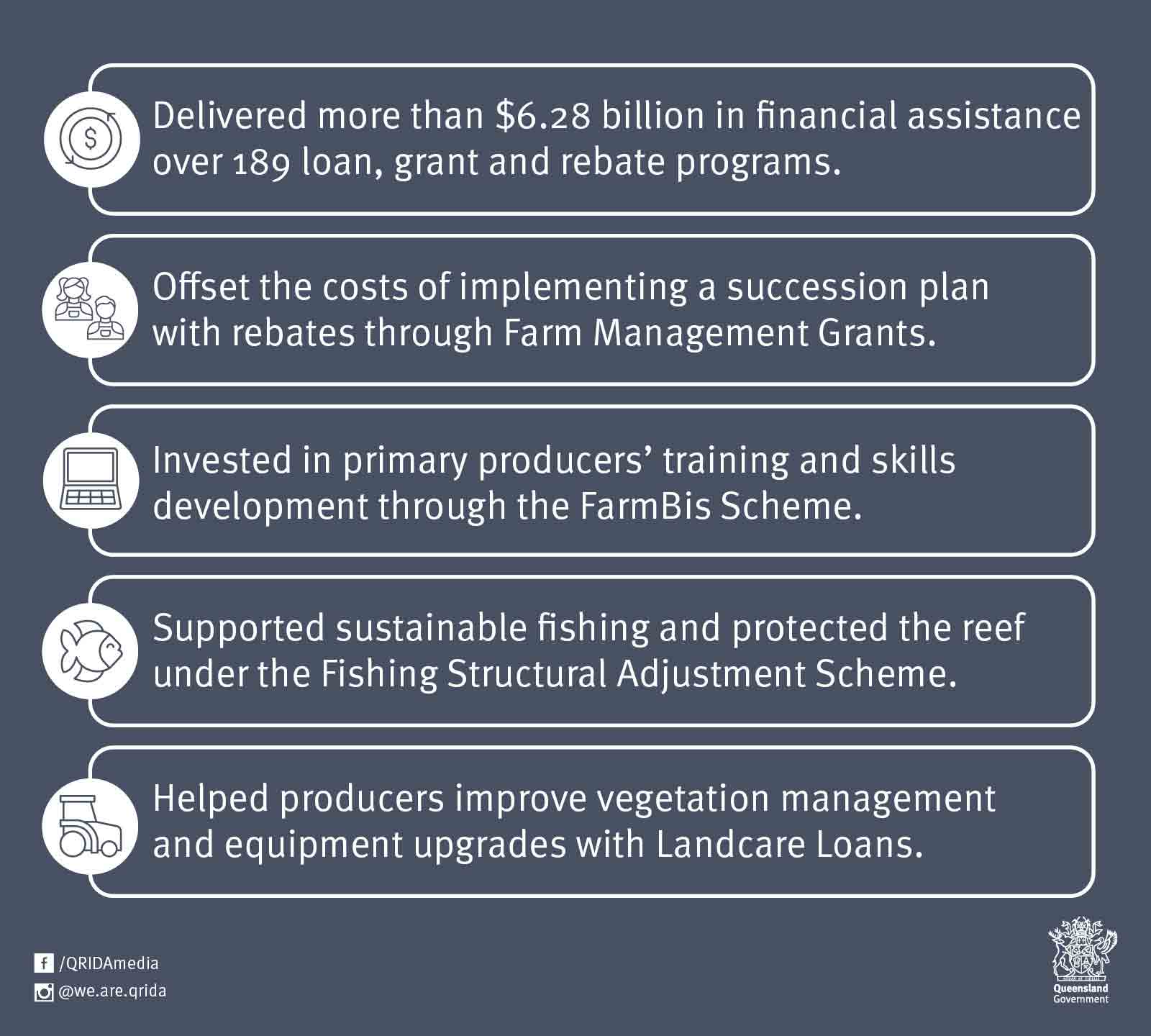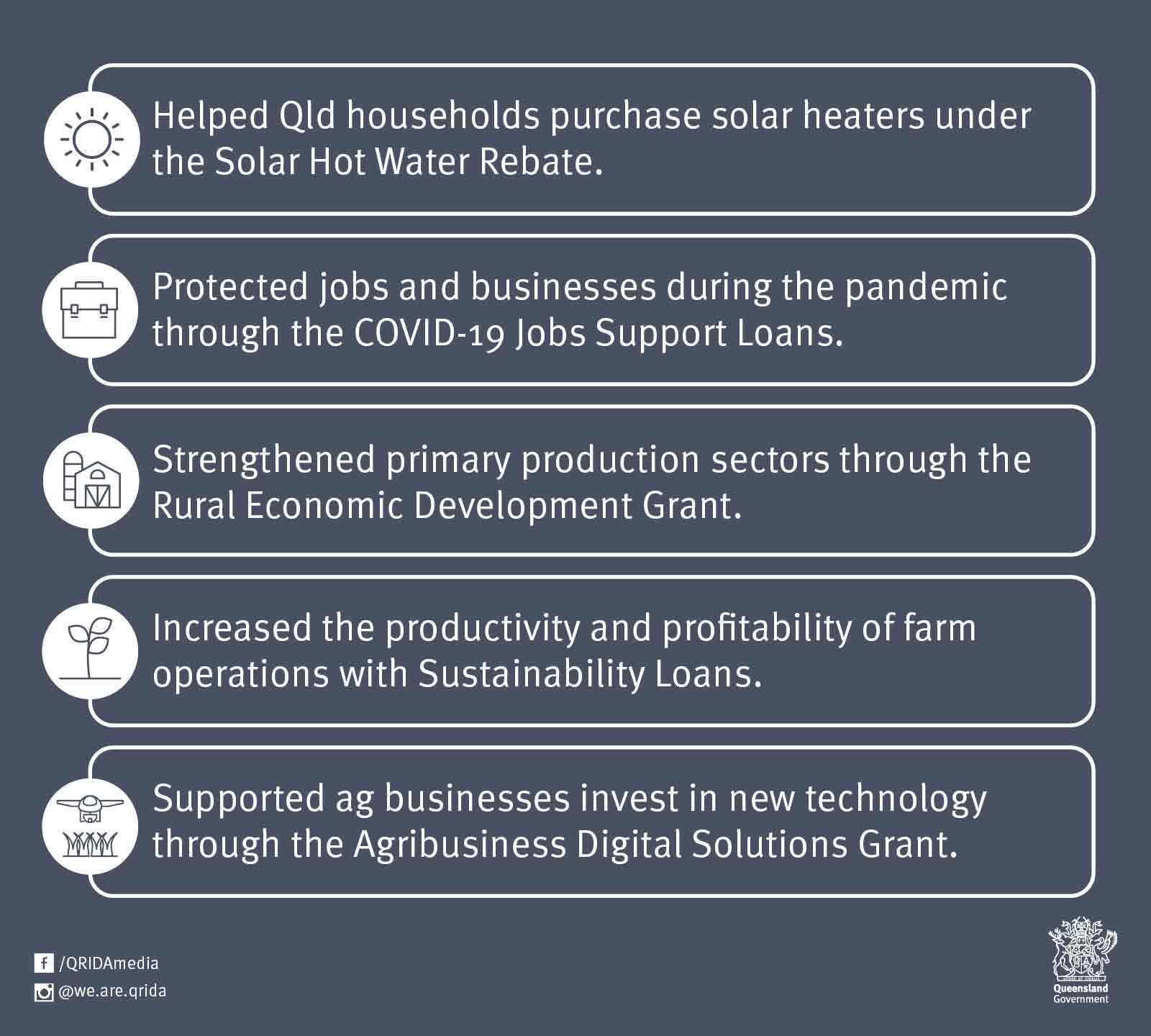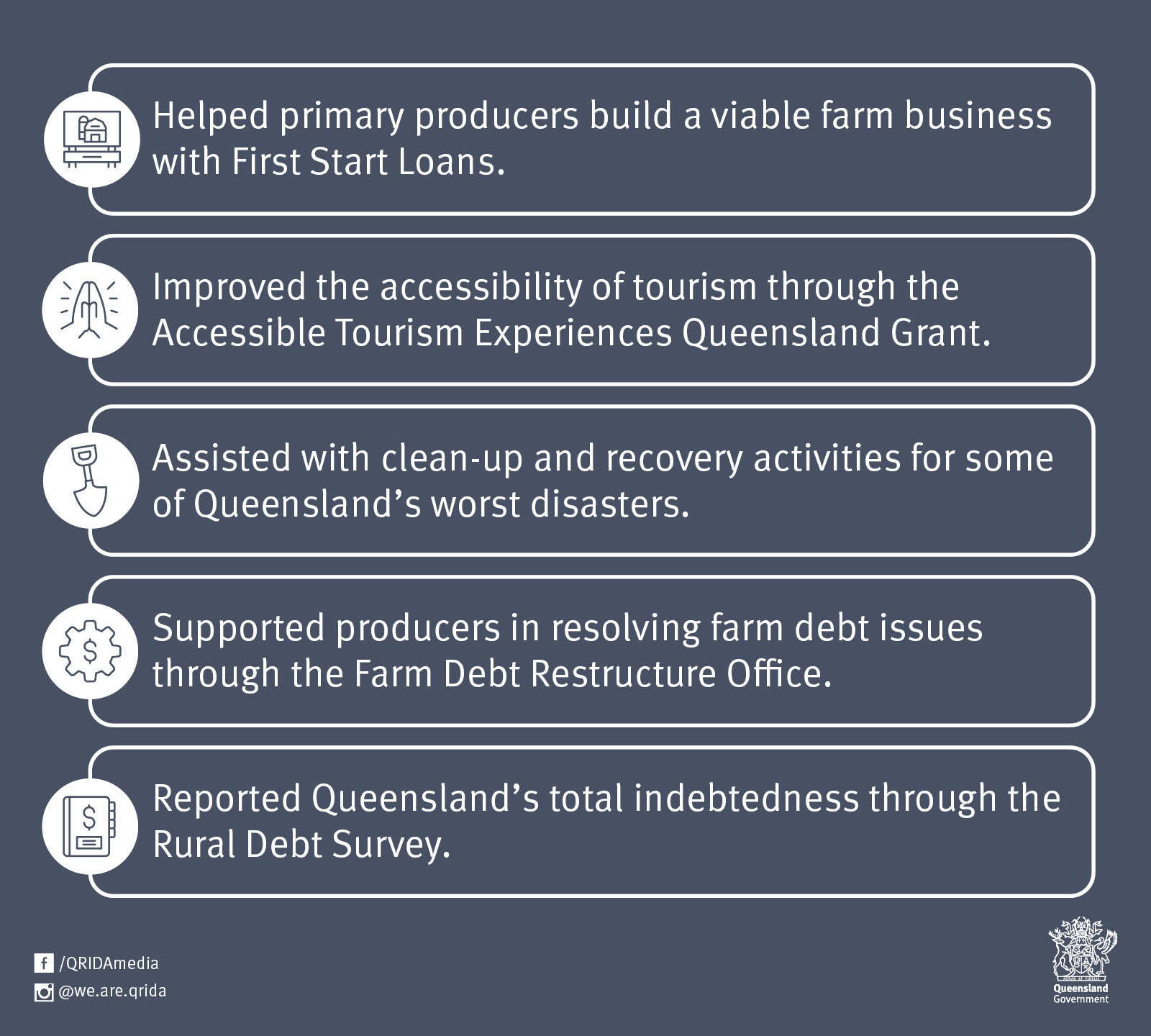Celebrating 30 Years of Excellence: QRIDA's Milestone Anniversary
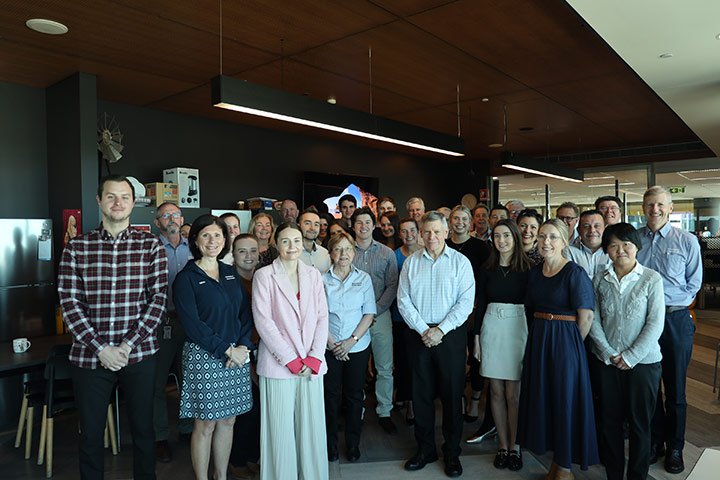
Happy birthday to us!
On 1 October 2024 QRIDA celebrated our 30th birthday!
For three decades, QRIDA has been at the forefront of supporting Queenslanders by administering financial assistance to primary producers, businesses, non-profit organisations and individuals. This momentous occasion marks not just the passage of time but also our ongoing commitment to fostering growth, innovation, and resilience in our communities.
Watch below to find out how QRIDA has helped rural and regional communities overcome challenges and succeed since it was established on 1 October 1994.
Our journey
QRIDA has come a long way since our early beginnings in 1994 when we were originally known as the Queensland Rural Adjustment Authority (QRAA), reporting to the state government.
Since QRAA was established in 1994, its core business has been administering concessional loans and grants to help Queensland primary producers get started, expand and diversify their operations.
QRAA's growing success as a loans and grants administrator began catching the attention of more government departments across the nation and in 2011 the organisation delivered its first consumer-targeted program, the Solar Hot Water Rebate Scheme.
In the years that followed, QRAA continued to prove itself as an important tool for governments, triggering reforms to the Rural and Regional Adjustment Act 1994.
In July 2017, as a result of the Farm Business Debt Mediation Act 2017 (Qld), QRAA's name was changed to the Queensland Rural and Industry Development Authority (QRIDA) to reflect the organisation’s increased role and responsibilities, doing even more for rural and regional Queensland.
Building on our existing role within rural and regional communities, over the past 30 years the scope of the programs we deliver has broadened, delivering high-quality, efficient and tailored programs for various state and Commonwealth government agencies that have provided assistance for a diverse range of applicants.
Although many significant changes and developments have occurred since QRIDA began operation, our organisation remains committed to bolstering Queenslanders with our diverse range of financial administration services and support
To celebrate QRIDA turning 30, we're taking a step back in time to reflect on our achievements and take a look at what the future holds for the organisation. Keep an eye on this page for updates!
QRIDA's history
1994 to 1998
It was an era when the internet changed how we worked, export commodities like wheat and dairy were deregulated, and the millennium drought began.
Our establishment dates back to October 1, 1994, when the Government Schemes Division completely separated from the Queensland Industry Development Corporation (QIDC).
Under the Rural and Regional Adjustment Act 1994 (Qld), QIDC became the Queensland Rural and Adjustment Authority (QRAA), reporting to the Queensland Government.
The main function of QRAA was to deliver financial assistance programs that fostered sustainable and resilient rural and regional Queensland communities.
Between 1994 and 1998, QRAA delivered more than $157 million in financial assistance programs.
The financial assistance helped primary producers get started in agriculture, improve the productivity and profitability of their enterprises, and prepare for and recover from disasters and droughts.
1999 to 2003 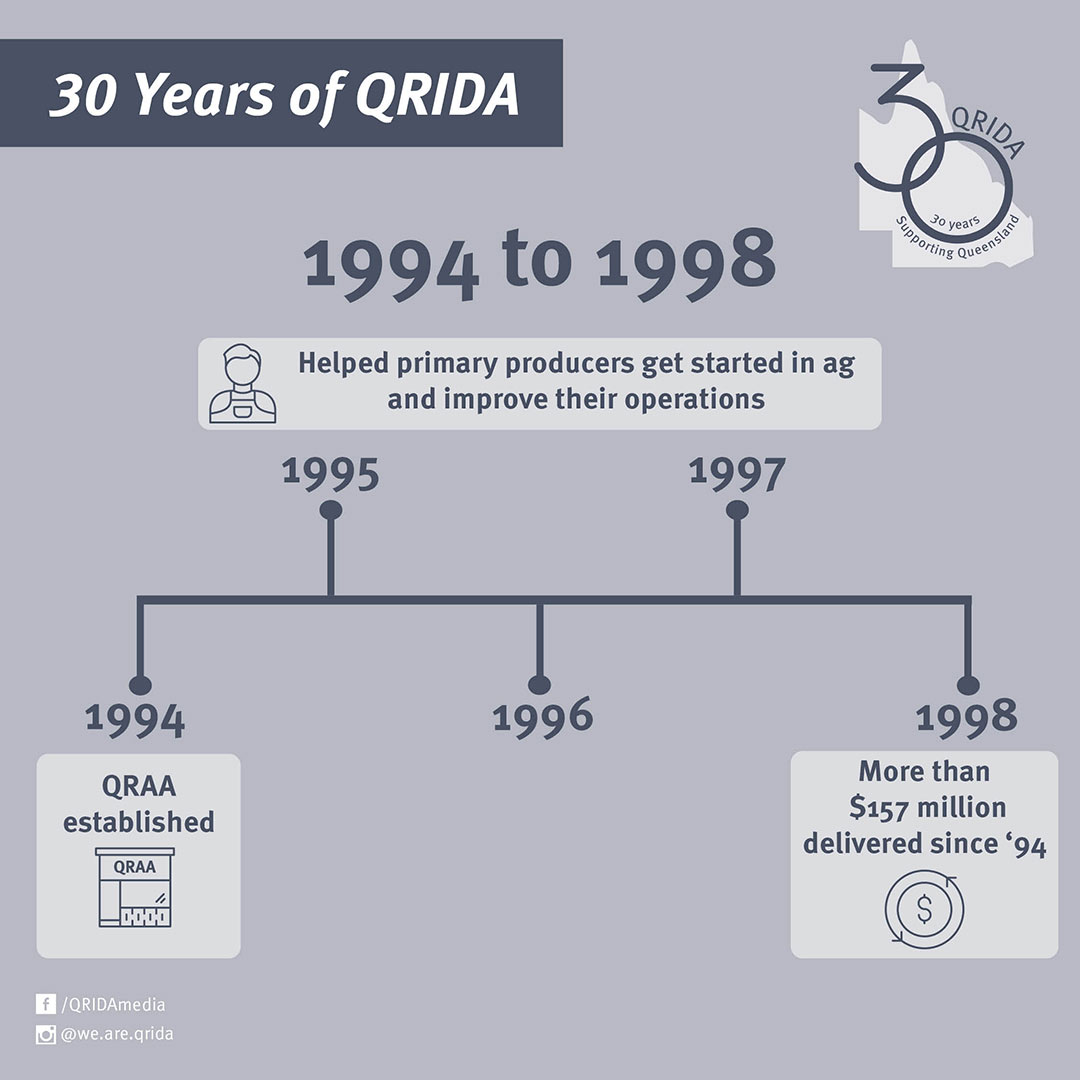
During this era the impacts of the millennium drought were being felt across the agricultural industry and wider economy, there were an estimated 27,000 farms in Queensland, and majority of operations were beef cattle or sugar cane.
With more than 65 per cent of Queensland officially drought-declared by August 2003, the majority of QRAA Landcare Loans between 2002 and 2003 were used to help fund water supply activities such as bore drain replacements and additional water points.
Landcare Loans were non-means tested, concessional loans of up to $100,000 per annum to help landholders carry out sustainable property improvements from vegetation management to machinery upgrades.
Between the 2002 - 2003 financial year, QRAA also administered $10.3 million for training and skills development for eligible primary producers through the FarmBis scheme.
Overall, QRAA delivered over $134 million in financial assistance between 1999 and 2003 to help strengthen rural and regional Queensland economies and facilitate the sustainable development of primary production operations.
2004 to 2008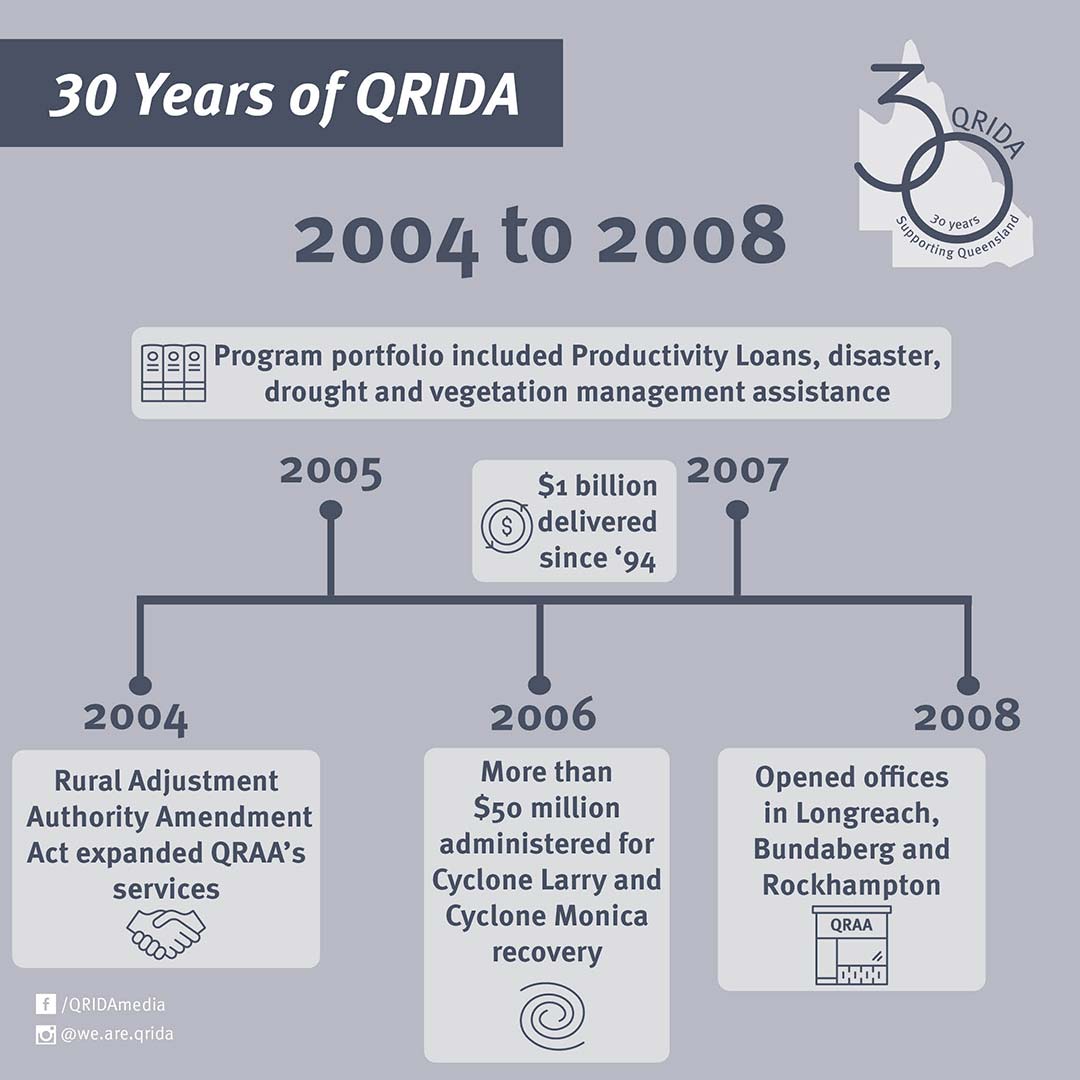
During 2004 to 2008 continued drought conditions and severe cyclones impacted the state, exotic pests and diseases like giant African snail and citrus canker were on top of Queensland’s biosecurity priorities, and industries like grain were enjoying high prices while cotton recorded its lowest gross value of production in a decade.
In 2004, the Rural Adjustment Authority Amendment Act was passed to expand the financial assistance programs QRAA could deliver.
Following the Act, QRAA was able to administer financial assistance programs on behalf of Commonwealth, Queensland and other state governments that were primarily, but not exclusively, targeted at fostering a more productive and sustainable rural and regional sector.
In March 2006, Cyclone Larry hit Innisfail as a category four system and was considered Queensland’s worst cyclone in more than 70 years. Less than a month later, an even more intense category five system, Cyclone Monica, made landfall near Lockhart River.
Both cyclones left a devastating impact on Far North Queensland, and QRAA delivered more than $50 million to help impacted primary producers and small businesses with the clean-up and recovery.
In October 2006, QRAA surpassed more than $1 billion administered in financial support for Queensland industry since it commenced operations in 1994.
At the time, QRAA Chief Executive Officer, Colin Holden, said of the milestone “QRAA’s success as a program administrator stems from our willingness to continually improve our organisation.”
QRAA’s 2007 Rural Debt Survey recorded a total of $11.28 billion in rural debt during 2005 to 2007, with 80% of the total debt considered to be viable or potentially viable in the long-term.
The highest levels of debt were recorded by the beef, cotton, and grazing/grains industries, with the Maranoa/Western Downs, Central South Coast, and Eastern Downs regions recording the largest debt increases.
At the end of 2007, QRAA opened new regional offices in Bundaberg, Longreach, and Rockhampton, in addition to its regional presence in Toowoomba, Roma, Kingaroy, Mackay and Innisfail, and its head office in Brisbane.
The regional expansion gave primary producers an even more personalised QRAA service, with a 2008 customer satisfaction and awareness survey recording a 4.3 out of 5 for high quality customer service.
During this period, QRAA’s program portfolio included Productivity Loans (Development, First Start and Resource Management Loans), the Cyclone Larry and Monica Natural Disaster Relief Assistance Package, Exceptional Circumstance Drought Interest Subsidy Support, Drought Carry-on and Drought Recovery Loans, and the Vegetation Management Financial Assistance Package.
2009 to 2013 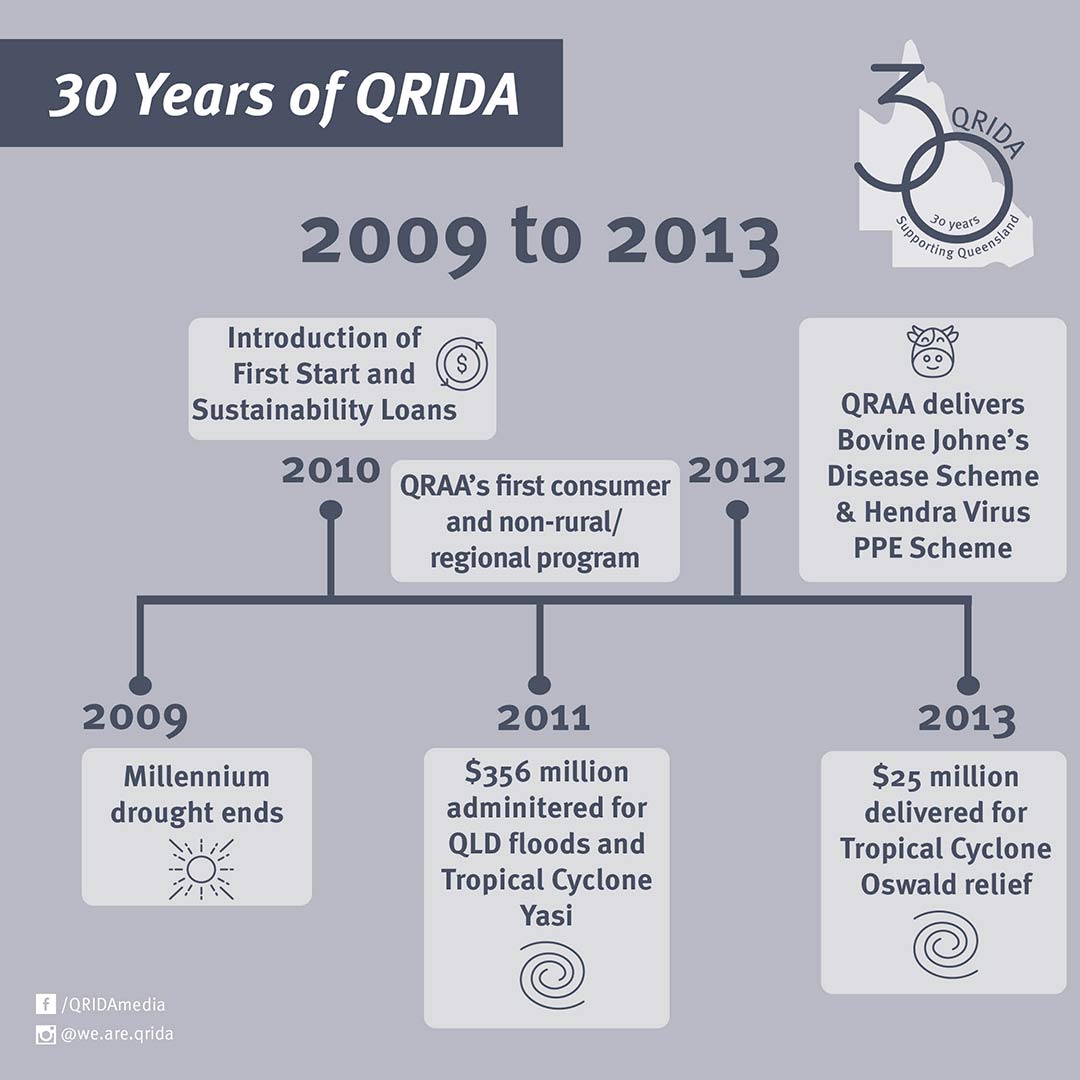
In the 2009 to 2013 era, the Millennium Drought ended after over a decade, Queensland experienced one of its most devastating flooding events in recent memory, and drones began taking flight in agribusinesses.
In December 2010, amendments to the Primary Industry Productivity Enhancement Scheme (PIPES), administered by QRAA, were implemented and its two main loan facilities changed to First Start and Sustainability Loans.
The maximum loan limits increased from $500,000 to $650,000 to better reflect the rise in rural property values at the time and the eligible activities were expanded to include on-farm improvements like wind and solar.
Queenslanders will remember the summer of 2010-2011 for its devastating flooding and Tropical Cyclone Yasi, which together impacted nearly the entire state and left a damage bill worth billions.
In the aftermath of these disasters, QRAA received an unprecedented volume of enquiries and financial assistance applications and responded to this increased volume by increasing staff numbers, streamlining procedures, and making effective use of technology.
QRAA administered more than $256.7 million in disaster relief and recovery for the 2011 Queensland floods, and more than $99.8 million for Tropical Cyclone Yasi to impacted primary producers, small businesses, and non-profit organisations.
Between October 2010 and June 2011, QRAA delivered its first consumer-targeted and non-rural/regional-based program, the Queensland Government’s Solar Hot Water Rebate Scheme. QRAA processed 14,379 rebate applications to assist the Queensland Government meet its target of doubling the state’s use of solar energy more than three years ahead of schedule.
Throughout the 2012-2013 financial year, a significant increase in demand for First Start and Sustainability loans resulted in 250 applications and a then record $78.9 million being approved to new and existing producers.
During this time, QRAA also played a major role in helping primary producers improve the biosecurity of their operations, administering the Bovine Johne’s Disease Assistance Scheme – to help graziers who suffered financial loss due to the loss of cattle related to the outbreak of BVJ - and the Hendra Virus Personal Protective Equipment Scheme – to offset the purchase of PPE equipment for veterinary surgeons at risk of exposure to the Hendra Virus.
In 2013, record flooding swept through Bundaberg and parts of the Fraser Coast Region as a result of Tropical Cyclone Oswald.
In his role as QRAA Regional Area Manager for Wide Bay and Fraser Coast, Mark Barrett, (who is still in the role today), visited impacted primary producers, small businesses, and non-profit organisations to spread the word about QRAA’s disaster financial assistance. Mark recalled it was “rewarding from our work with our clients to actually see the benefits made on the ground in their businesses”.
2014 to 2018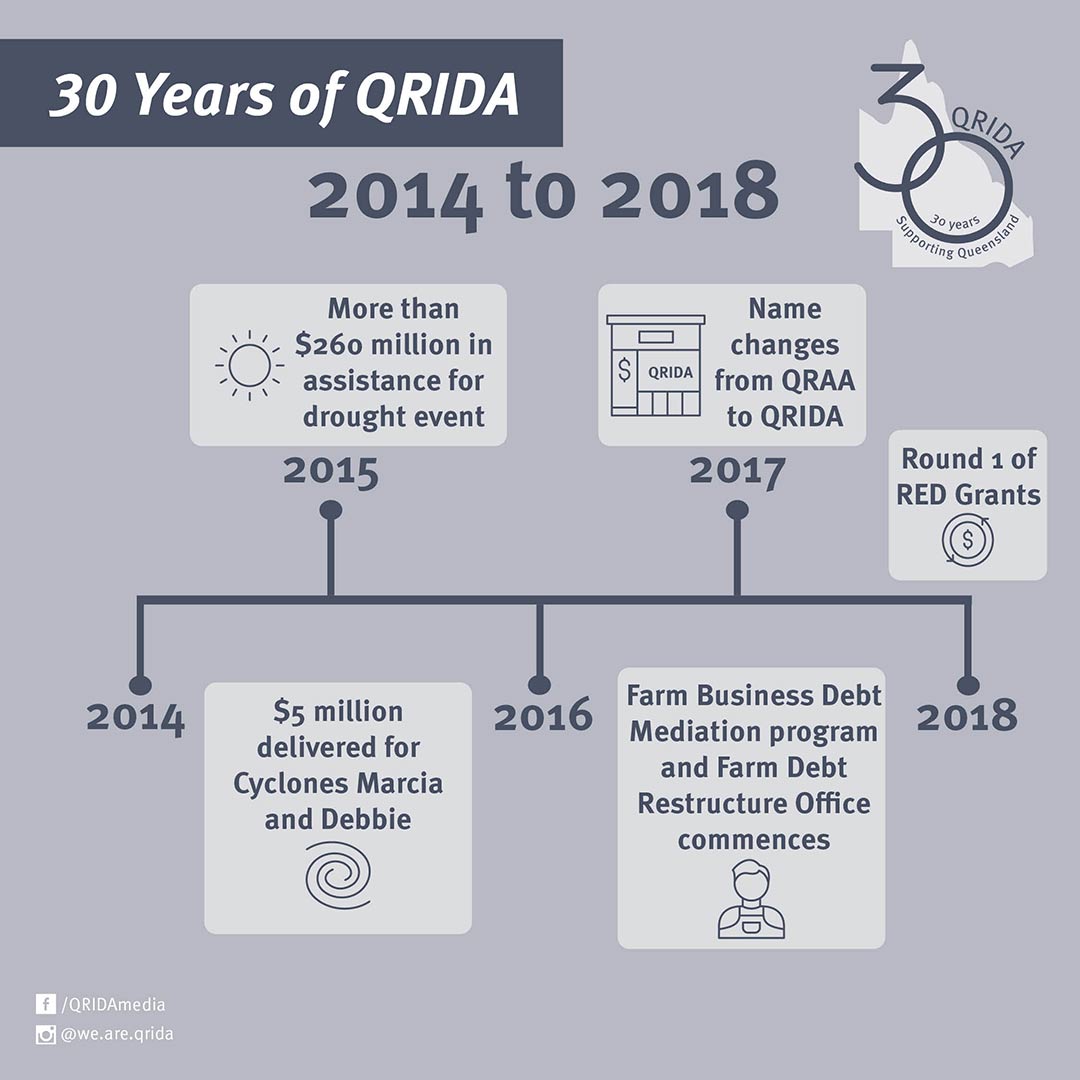
This week, we’re looking back on 2014 to 2018, when the first case of banana disease Panama TR4 was detected in Far North Queensland , agricultural exporters benefitted from a lower Australian dollar and agritourism grew in popularity.
In 2015, more than 80% of Queensland became drought-declared , and by 2016, QRAA had delivered more than $260 million in loans to over 270 producers who were impacted by the dry event.
In the midst of these drought conditions, Queensland was also hit by a series of disasters. QRAA administered more than $585,000 in disaster financial assistance for Tropical Cyclone Marcia which impacted Central Queensland in 2015, and $4.5 million for Cyclone Debbie which damaged areas of the Whitsundays in 2017.
In 2017, as a result of the Farm Business Debt Mediation Act 2017 (Qld), our name was changed from the Queensland Rural Adjustment Authority (QRAA) to the Queensland Rural and Industry Development Authority (QRIDA) to reflect the organisation’s increased role and responsibilities, doing even more for rural and regional Queensland.
From 1 July 2017, the Farm Business Debt Mediation program also replaced the voluntary mediation scheme that was part of the Queensland Farm Finance Strategy. To date, the program continues to provide an efficient and equitable way for farmers and mortgagees to attempt to resolve matters relating to farm business debts.
Amendments to the Rural and Regional Adjustment Act 1994 (Qld) in 2017 made QRIDA responsible for undertaking the Queensland Rural Debt Survey every two years.
In 2018 the Farm Debt Restructure Office commenced. The Office administers the Farm Business Analysis Assistance (FBAA) program, which provides farmers a funded package to access financial experts to analyse their enterprise and provide a range of debt restructure options to address the farmer’s situation.
That same year, QRIDA delivered Round 1 of the successful Rural Economic Development Grants program to help fund agricultural projects that create jobs for rural Queenslanders.
2019 to 2024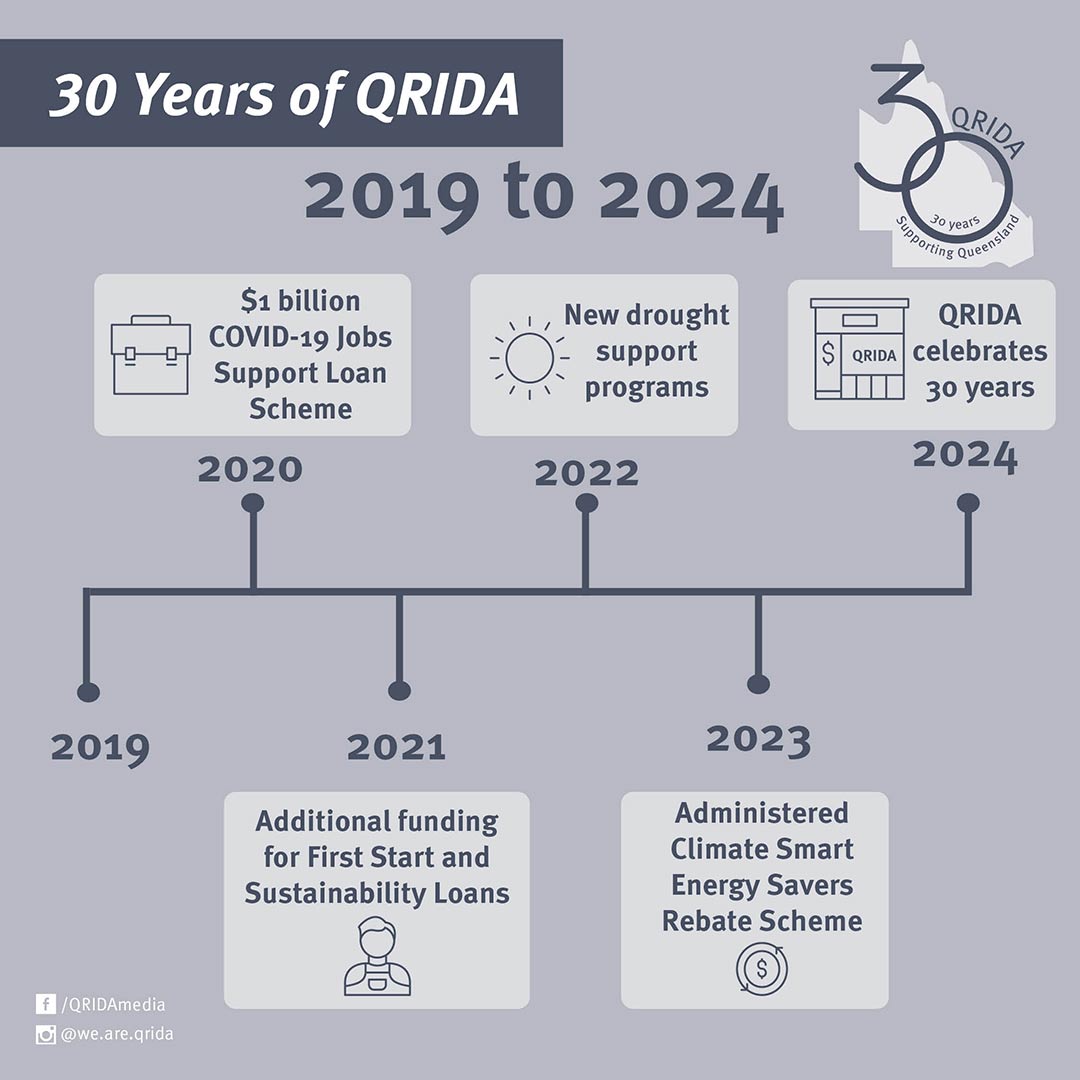
In our latest era, COVID-19 disrupted the economy, flooding, bushfires and cyclones tested the resilience of the state and Queensland became drought-free for the first time in 11 years.
During the worst impacts of the pandemic, QRIDA delivered the Queensland Government’s $1 billion COVID-19 Jobs Support Loans to assist more than 7,000 businesses and support over 86,000 local jobs.
In 2021, the Queensland Government committed another $20 million in funding for the concessional First Start and Sustainability Loans that QRIDA administers, and in 2022, small-scale rural workers accommodation was included as an eligible activity for Sustainability Loans to address job shortages impacting farms.
In 2022, QRIDA began delivering the Queensland Government’s new drought assistance programs that focus on fostering greater preparedness and resilience of Queensland primary production operations.
From droughts and bushfires to cyclones and floods, QRIDA continued to help primary producers, small businesses and non-profit organisations recover from extreme weather conditions, with communities especially impacted by the repeated disaster events between 2022 and 2023.
During this time, QRIDA continued to expand its portfolio of government financial assistance programs, delivering a range of non-regional/rural funding including the unprecedented Climate Smart Energy Savers Scheme and the Zero Emissions Vehicle Rebate Scheme.
QRIDA also began delivering the complex Fisheries Structural Adjustment Scheme to support sustainable fishing and protect the reef.
More than $6.15 billion has been delivered in financial assistance by QRIDA as we celebrate our 30-year anniversary.
As we reflect on QRIDA’s milestones leading up to our 30th birthday, it’s clear we wouldn’t have been able to help create such thriving and resilient rural and regional Queensland communities without our valuable clients and hard-working allies and stakeholders.
We’d like to thank everyone who has been part of QRIDA’s, and its predecessor, QRAA’s journeys since 1994, and we look forward to another 30 years of helping Queenslanders overcome challenges and succeed with financial assistance.
30 Ways QRIDA has shaped Queensland in 30 years
As QRIDA surpasses its 30-year anniversary, we're reflecting on 30 ways QRIDA has helped Queenslanders recover from challenges and thrive over 30 years. Read more about how QRIDA has helped Queenslanders here.
